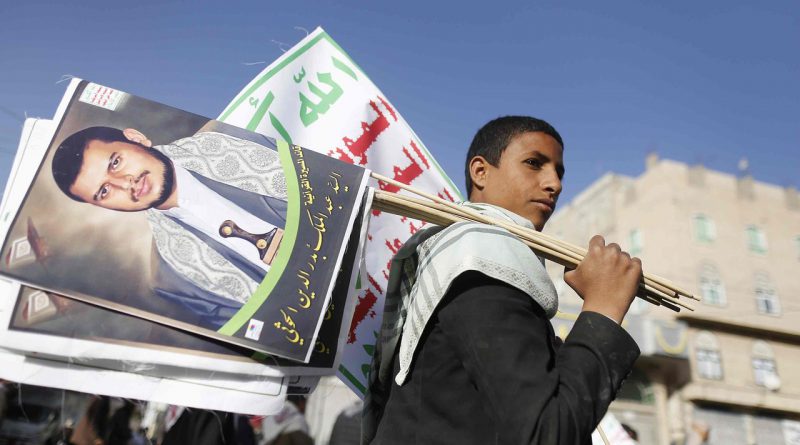ANALYSIS: Houthi “Khums” Tax at the center of Iran’s Geopolitical Strategy
by Irina Tsukerman
The ultimate ambition for the Islamic Republic is not merely control over the regional “Shiite Crescent,” but the resurrection of a chimera of the Persian Empire based on Khomeinist ideological principles.
While most of the Western world is preoccupied with Iran’s role in Iraq and Syria, Yemen—the “forgotten conflict”—remains an integral and growing theater of operations for the expanding Iranian sphere of influence.
The Houthis of Yemen are much more than the nemesis of Saudi Arabia. They are radicalized Shiites with Persian roots. While they come from a once peaceful Zaidi tradition, they are increasingly a global menace. They have threatened the UAE and Israel and have expressed hatred for the US.
By taking advantage of side conflicts between other Yemeni factions, such as the separatist Southern Traditional Council (which has broken with the fragile Riyadh agreement and declared autonomy in part of Aden) and the local Muslim Brotherhood branch (known as the Islah Party and Brigade), the Houthis have been expanding their territorial control while making a political power grab. They are essentially displacing the internationally recognized Hadi government, which is now in exile.
With the rise of the Houthis, Yemen has become a global hub for ballistic missile import, terrorist operations, and centralized corruption and money laundering. While many analysts have recommended a strategy to separate the Houthis from their Iranian masters and funders, this advice has largely fallen on deaf ears. This could be due to the sheer commitment and level of coordination required for such a task, the US move away from participation in long-term strategic operations, or the differences and miscommunication among the anti-Iran Arab states. In any case, as the Houthis consolidate their control over the country and gain international legitimacy while integrating into the broader network of Iran’s other regional and international proxies, this approach is becoming increasingly difficult to implement.
The relationship between the Houthi movement’s founders and the Islamic Republic predates the current civil war, which started with the “September Coup.” Tehran’s strategy of exporting the Islamic Revolution took root when it figured out a way to do so cheaply, without having to spread its military everywhere: by coopting Shiite-leaning local grievance groups, separatist movements, and ostracized factions. By doing this, Iran could build entire armies of followers. As the expense of foreign adventurism began to add up, Iran turned these affiliates into effective fundraisers.
Iran has transformed its Lebanese proxy Hezbollah into a lethal quasi-formal military that also runs criminal schemes around the world. Hezbollah can be thrown into any theater of war to supplement the IRGC and other Iran-backed forces. Hezbollah is also used to train other forces. Groups like the Houthis were promised eventual power and control in exchange for complete fealty not just to Iran as a power but to Khomeinist principles.
After Hezbollah, Iran set about training similar forces in Iraq, Syria, and Nigeria, and is even eyeing converts in Latin America. While Hezbollah runs Iran’s shadow economy through a globalized organized crime network, the Houthis supplement this effort by fundraising for Hezbollah.
Their relationship evolved over time, with the Houthis morphing from a separatist movement allegedly confronting state corruption into a miniature model of Iran itself. It has a similar approach to governance, a colonialist frame of reference for running the country, and a deep-rooted racism applied to policies with increasing formality.
The Houthis practice preferential treatment in the distribution of humanitarian aid in the territories they control, using it as an incentive to recruit followers for their militias. A recent and broad-reaching example is the “Khums” tax, which exacts 20% of all public and private property as a tribute to the “Hashemites,” descendants of the tribe into which the Prophet Muhammad was born. The tax has been widely condemned by most of the country as discriminatory, outdated, and religiously unfounded.
It does in fact have previous applications in Yemen’s past, even if the origins of the idea may be obscured by history.
Dr. Arwa Khattab, an academic writer and human rights activist based in Berlin, spoke at a recent symposium about a much earlier era in which the tax was applied in Yemen. The Houthis are using that earlier instance to justify their reimposition of the tax as compensation for past alleged discrimination.
The tax was first introduced 1,300 years ago by the Imam Yahya Ibn Hussein. It came in the context of a power grab by local self-declared Hashemites who were issuing fatwas and rulings to help them consolidate power and wealth. Later, Imam Abdullah Ibn Hamza would use it to confiscate the property of 100,000 members of the Mutafiya sect. In the 17th century, Imam Mutawakkil once again imposed the measure. The last time this forcible confiscation of funds took place was during the period of imams, from 1918 until 1962. During that time the Yemenite people suffered multiple famines, but the money was nevertheless demanded of them and the grain they were forced to hand over rotted in the imam’s warehouses.
The timing of the Houthis’ imposition of the new tax is no coincidence. Up to this point, they have been making illicit profits by looting hospitals, diverting humanitarian aid, and running schemes. In April, however, members of WHO announced they would be cutting aid to Yemen by half due to the inability to track where it was going and to allegations of the Houthis’ systematic appropriation of the resources.
At the same time, the global context of the tax is more significant. The text of the measure that has been imposed by the Houthis—despite the lack of a parliament to approve it into law—allocates a portion of land and natural resources, including mines, to the Hashemites. It even diverts mandatory zakat (charity) away from the poor and toward the Hashemites. This could be seen as a ploy to fill Houthi war coffers for the sake of their ongoing efforts against the Arab Coalition, but the story is more complex. True Hashemite descent is very difficult to prove, but the simple claim of being a Hashemite earns a level of respect among Khomeinist followers. Hezbollah’s Hassan Nasrallah and even some of the ayatollahs claim to be of Hashemite descent.
Why the need for this sham? Iran is taking advantage of regional chaos and a vacuum of power to consolidate control over local resources and destabilized states, and is imposing the Khomeinist system of governance wherever it can. The ultimate ambition for the Islamic Republic is not merely control over the regional “Shiite Crescent,” but the resurrection of a chimera of the Persian Empire based on Khomeinist ideological principles. The object is to combine extreme nationalism and ethnocentrism based on a mythological perception of Iran’s history, as well as revolutionary Shiite Islamism.
However, to secure religious legitimacy in the region, particularly among Sunnis, Iran needs to gain access to Mecca and Medina, holy sites for all Muslim sects. Achieving that goal will not be easy given that not all Shiites, much less Sunnis, are on board with Iran’s geopolitical agenda. For that reason, Iran is seeking to reintroduce the concept of Hashemites as the sole religious and political authority (in the Islamist view). The idea is to delegitimize and displace governments in those Arab/Muslim majority states that are not governed by descendants of the Hashemites (Morocco and Jordan).
Saudi Arabia, Iran’s regional foil, is the ultimate target of this maneuver. Building support for Hashemite control will take time, but Iran is willing to align itself with any state, organization, movement, or entity that shares its agenda, if only until the goal of displacing inconvenient governments is accomplished.
The imposition of the Khums tax is the first step toward a systematic reintroduction of these principles to the region on a mass scale. Iran might have made successful inroads with this strategy due to the US withdrawal from regional affairs—or perhaps the US was forced to withdraw because of Iran’s overwhelming aggression, which made it impossible for the US to maintain a serious presence. Whichever of these is the case, Iran is continuing to expand its influence with little pushback. Even its seemingly localized proxies, such as the Houthis, are coordinating with better known militias and are becoming an integrated part of a network that presents a global, not just a regional, threat.
Article first appeared on The Begin-Sadat Center for Strategic Studies.
Irina Tsukerman is a human rights and national security attorney based in New York. She has written extensively on geopolitics and US foreign policy for a variety of American, Israeli, and other international publications. She tweets under @irinatsukerman.



